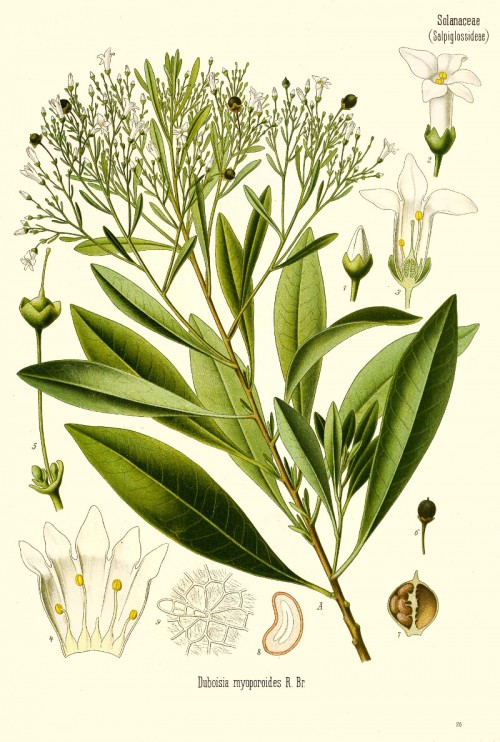Duboisia myoporoides R.Brown - Solanaceae - corkwood, Kleinblütige Duboisie
Shrub or tree, to 20m high, native to the eastern coast of Australia; bark thick, corky; Leaves obovate to elliptic; flowers white with purple striations in throat.
http://plantnet.rbgsyd.nsw.gov.au/cgi-bin/NSWfl.pl?page=nswfl&lvl=sp&name=Duboisia~myoporoides
Scopolamine was the major alkaloid of D.myoporoides leaves collected from different localities in Queensland representing high and low altitudes in semitropical and tropical regions.
[ Alkaloid variation within Duboisia myoporoides. Gritsanapan, W., Griffin, W. J., Phytochemistry, Vol.30(8), 1991, 2667-2669]
There are several minor tropane alkaloids present in the plant, as e.g. atropin, butropine, valtropine, apoatropine and 6β-hydroxyhyoscyamine, as well as pyridine alkaloids like nicotine. „Australian plantations of Duboisia
species and hybrids remain the major world sources of scopolamine and atropine (~70% of world supply). Since 1980, all exported Duboisia leaf has been derived from cultivated plants. Plantations of D.myoporoides and
D.leichhardtii and of hybrids of the two species (which have the dual advantages of higher tropane and negligible pyridine alkaloid levels) produce leaf with an alkaloid content of up to 5–7% by dry weight, of which about half is scopolamine.“
[Duboisia myoporoides: The Medical Career of a Native Australian Plant. Paul Foley, Historical Records of Australian Science Vol.17(1), 2006, 31-69]
„Alkaloids derived from solanaceous plants were the subject of intense investigations by European chemists, pharmacologists and clinicians in the second half of the nineteenth century. Some surprise was expressed when it was discovered in the 1870s that an Australian bush, Duboisia myoporoides, contained an atropine-like alkaloid, 'duboisine' [scopolamine]. A complicated and colourful history followed. Duboisine was adopted in Australia, Europe and the United States as an alternative to atropine as an ophthalmologic agent; shortly afterwards, it was also esteemed as a potent sedative in the management of psychiatric patients, and as an alternative to other solanaceous alkaloids in the treatment of parkinsonism. The Second World War led to renewed interest in Duboisia species as sources of scopolamine, required for surgical anaesthesia and to manage sea-sickness, a major problem in the naval part of the war. As a consequence of the efforts of the CSIR and of Wilfrid Russell Grimwade (1879-1955), this led to the establishment of plantations in Queensland that today still supply the bulk of the world's raw scopolamine. Following the War, however, government support for commercial alkaloid extraction waned, and it was the interest of the German firm Boehringer Ingelheim and its investment in the industry that rescued the Duboisia industry in the mid-1950s, and that continues to maintain it at a relatively low but stable level today.“
[Duboisia myoporoides: The Medical Career of a Native Australian Plant. Paul Foley, Historical Records of Australian Science Vol.17(1), 2006, 31-69] http://www.ausbushfoods.com/reports/Species/duboisiacsiro.pdf

Köhler,F.E., Medizinal Pflanzen, vol.3 t.26 (1890)
http://plantgenera.org/species.php?id_species=364975